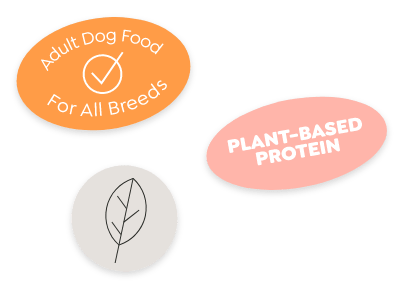LEADING
THE PACK
We hold our products and business practices to the highest standards of nutrition, manufacturing, and sustainability. See how other popular brands compare.
COMPARE MORE DIETS
+HOW WE GRADE
While every dog is a
10 out of 10, judging their food requires a more critical lens
We evaluate foods using third-party evaluation criteria - like recommendations from the World Small Animal Veterinary Association (WSAVA) and sustainability metrics from the University of Michigan - to ensure our scoring method is evidence-based and reflects expert opinion.

NUTRITION
TOP INGREDIENTS
What are the main ingredients? Where do they come from and how processed are they?
Scoring
Of the top 5 ingredients on label:
Whole, unprocessed foods (+1 pt)
Processed plant-based proteins or derivatives (+0.5 pt)
Processed animal by-products (+0 pt)
Rationale
There are different opinions about optimal nutrient ratios, but most nutritionists agree that “whole” foods - i.e. minimally processed and/or fresh - are preferable.
Processing - whether rendering and drying animal flesh into meat meal, separating grains into different components, or concentrating proteins - strips some nutrients and also introduces additional steps in the supply chain for issues to emerge.
Processed animal by-product is particularly problematic because it likely includes meat from sick or dead animals that are deemed unfit for human consumption due to safety concerns.
-
EXPERT-FORMULATED
Is the formula created by experts?
Scoring
Named board-certified veterinary nutritionist or animal nutrition Ph.D (+1 pt)
Named credentialed veterinary nutritionist (+0.5 pt)
Does not name the formulator(s) (+0 pt)
Rationale
WSAVA recommends companies that employ a full-time nutritionist who holds either a PhD in animal nutrition or board certification from the American College of Veterinary Nutrition.
Full-time employment is not necessary or feasible for many companies with a more limited product catalog, so we award partial points to companies that name qualified nutritionist formulators regardless of employment status.
RESEARCH
Has the company conducted research about the nutritional quality and health outcomes? Does the company substantiate health-related marketing claims?
+
APPROACH
Is the nutritional approach in line with the consensus of veterinary nutritionists?
+
LABELING
Does the brand provide additional nutritional information on par with human food labeling?
Scoring
Shares nutritional information about all essential nutrients (+1 pt)
Rationale
A single diet often accounts for 90%+ of a dog’s total calories, yet pet food companies rarely share meaningful nutritional information with pet owners.Current pet food regulations only require companies to share limited nutritional information.
The guaranteed minimum percentage of protein and maximum percentage of fat, fiber, and moisture.
Pet nutritional experts advocate for companies to share more nutritional information, including information that is legally required on human food labels. The gold standard is sharing a lab-verified analysis of all the nutrients that AAFCO considers essential to canine nutrition.
TESTING
Does the brand share metrics about the digestibility of the food?
+
SUPPLY CHAIN
Does the brand share information about its suppliers and/or manufacturer?
+
PRODUCTION
HEAT EXPOSURE
How is the food made?
Scoring
Lightly-Cooked “Fresh” (+4 pt)
Canned & Dehydrated (Air, Freeze-Dried, etc.) (+3 pt)
Dry - Baked (+2 pt)
Dry - Extruded / Pressure-Cooked (+1 pt) Raw (+0 pt)
Rationale
Heat has an important role in nutrition and safety. Cooking food is critical to kill potentially toxic microorganisms.
It also makes many plant-based nutrients more digestible and accessible. However, applying a lot of heat can also degrade protein, particularly the amino acid lysine, as well as many vitamins.
Moderately-cooked “fresh” food is generally the most digestible and has the least protein degradation. Canned foods have more preservatives added and are generally of lower quality to enable a long shelf life.
For dry foods, dehydrated meats are nutritionally similar to moderately-cooked “fresh”, but the lack of heat is not optimal for plant-based ingredients that often need some heat. Baked foods have some nutritional advantages over extruded foods, which are cooked at a high pressure for a short time - such as a lower glycemic index and less fat oxidation.
Most veterinary nutritionists warn against commercial raw food due to the high levels of toxic microorganisms that can make dogs or family members sick and similar or worse digestibility than cooked fresh food.
-
LIVESTOCK WELFARE
What are the welfare standards for animal-derived ingredients?
+
ANIMAL TESTING
Does the company use laboratory animals for testing?
+
RECALL HISTORY
What is the brand’s quality / safety record? Have they had any recalls or FDA cautions? Can the company communicate with customers in case of a product issue?
Scoring
USDA-inspected (food-grade) facility OR large manufacturer (>$500M sales) with no recall history (+3 pt)
Mid-Sized Manufacturer ($100-500M sales) with no recall history - (+2 pt)
Small Manufacturer (+1 pt)
Significant recall history(+0 pt)
Direct consumer relationship & batch tracking (+1 pt)
Rationale
Recalls are not a perfect proxy for safety, but are a quantifiable and public way to evaluate commitment to quality control.
Size is also an indicator of quality control practices, as brands producing large volumes of food without product recalls generally have more stringent quality control processes in place.
Certifications - such as USDA inspection required for facilities making “human grade” foods - can also be reasonably interpreted as higher quality control.
Companies that distribute their products directly to customers over the internet are better equipped to handle any safety issues as they can directly contact recipients of potentially impacted products.
-
SUSTAINABILITY
FRESH WATER & LAND USE
How much freshwater, land, and energy is required to produce the food?
Scoring
Primarily plant-, fungi-, or insect-based protein (+3 pt)
Primarily meat by-products (+2 pt)
Primarily poultry or pork (+1 pt)
Primarily beef, lamb, or fish (+0 pt)
Feed-grade (+1 pt)
Rationale
We used widely-accepted life cycle assessments that quantify the land use and freshwater withdrawals for different food sources.
Ruminants - i.e. cows and sheep (lambs) - generally require the most land and freshwater as they are the least efficient at converting feed into body mass so require more food, in the form of pasture land grass or grain feed. Farming fish is also extremely freshwater intensive.
Poultry and pigs are more efficient at converting food into mass, but are still more resource-intensive than consuming plants directly (with a few exceptions that are rarely used in pet food).
Pet foods that use true by-products - i.e. parts of animals that are considered inedible to humans - are more resource efficient as they are upcycling food that has limited other uses (generally feed for livestock or as fertilizer).
“Human grade” foods are most likely to be directly competitive with human food sources and drive the most incremental demand for additional agricultural outputs.
-
GREENHOUSE GAS EMISSIONS
How much does the food contribute to climate change?
Scoring
Primarily plant-, fungi-, or insect-based protein (+3 pt)
Primarily meat by-products (+2 pt)
Primarily poultry, pork, or fish (+1 pt)
Primarily beef or lamb (+0 pt)
Feed-grade ingredients (+1 pt)
Rationale
We used widely-accepted life cycle assessments that quantify the greenhouse gas emissions associated with different food sources. The largest greenhouse contributors are emissions related to land use changes ( such as deforestation to clear cropland), methane emissions (from livestock, fertilizer, and flooded soil), and carbon dioxide emissions from farm and boat equipment and synthetic fertilizer production. For animal ingredients, the emissions from the production of feed crops also plays a big role.
Ruminants - and especially cows - have far and away the highest carbon footprint due to the high methane production from gut fermentation of grass and grains.
Poultry and pig meat do not produce much methane but require crop feed that results in a 3x - 10x higher footprint than consuming most plants directly. Fish - both wild and farmed - emits similar GHG through boat fuel and farming equipment.
Pet foods that use true by-products - i.e. parts of animals that are considered inedible to humans - are allocated a lower share of the greenhouse emissions due to the limited alternative uses and lower economic value.
“Human grade” foods are most likely to be directly competitive with human food sources and drive the most incremental demand for additional agricultural outputs.
-
ORGANIC
Does the food support organic agriculture?
+
BIODIVERSITY
Does the food use ingredients that are grown in mono- or duo-cultures?
+
PACKAGING & DISTRIBUTION
How much waste does the food’s packaging and distribution create?
Scoring
Dry food w/ renewable packaging (+4 pt)
Dry food with conventional packaging (+3 pt)
Canned / shelf-stable wet food (+2 pt)
Refrigerated or frozen food sold through brick & mortar stores (+1 pt)
Refrigerated or frozen food sold primarily direct-to-consumer (+0 pt)
Rationale
Dry dog food requires less packaging per calorie than wet food, and the higher water content of wet food also requires more energy for transportation.
Shelf-stable dry food requires multiple layers of packaging to ensure it does not go stale, and the plastic or bio-plastic layers cannot be recycled or composted with current technology (at least for curbside trash pickup).
However, using renewable sources for the layers - such as paper and sugarcane - is more sustainable than entirely plastic-based bags.
Food that requires refrigeration consumes significantly more energy than shelf-stable wet and dry food. Buying refrigerated food at retail stores generally requires less waste than ordering online, as shipping food with ice packs and insulation dramatically increases packaging waste and transport energy.
-
EXPERT-FORMULATED
Does the company’s legal structure reward and encourage sustainability? What commitments has the company made to achieve their mission?
Scoring
Certified B Corp (+2 pt)
Shares a CSR or public benefit statement / mission (+1 pt)
Rationale
Certified B Corporations are a new kind of business that balances purpose and profit. They are legally required to consider the impact of their decisions on their workers, customers, suppliers, community, and the environment.
These businesses are evaluated and scored by an independent third-party (B Labs) and must provide radical transparency into their sustainability programs.
While this corporate structure is the gold standard for CSR, non-certified companies can start by drafting and sharing plans and commitments to benefit the community and environment.
COMMUNITY & EMPLOYEE INVESTMENT
Does the company invest in its community and employees? Does the company own its own manufacturing facilities and/or ingredient suppliers?
+
NON-PROFITS
Does the company support non-profit organizations aligned with its mission?














